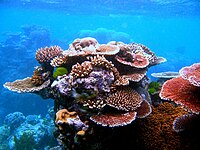
First evidence of asymmetric competition between the non-native clamCorbicula flumineaand the native freshwater musselUnio delphinusduring a summer heat wave
Sign Up to like & getrecommendations! Published in 2018 at "Aquatic Conservation: Marine and Freshwater Ecosystems"
DOI: 10.1002/aqc.2964
Abstract: Non‐native species introductions are a major concern for the conservation of natural ecosystems. The spread of non‐native species depends not only on their adaptation to the new environment, but also on the biotic features of… read more here.
Keywords: native freshwater; fluminea; evidence; competition ... See more keywords

Who is reporting non‐native species and how? A cross‐expert assessment of practices and drivers of non‐native biodiversity reporting in species regional listing
Sign Up to like & getrecommendations! Published in 2023 at "Ecology and Evolution"
DOI: 10.1002/ece3.10148
Abstract: Abstract Each year, hundreds of scientific works with species' geographical data are published. However, these data can be challenging to identify, collect, and integrate into analytical workflows due to differences in reporting structures, storage formats,… read more here.
Keywords: practices drivers; reporting non; biodiversity; native species ... See more keywords

Natives and non‐natives plants show different responses to elevation and disturbance on the tropical high Andes of Ecuador
Sign Up to like & getrecommendations! Published in 2017 at "Ecology and Evolution"
DOI: 10.1002/ece3.3270
Abstract: Abstract The aim was to assess patterns of plant diversity in response to elevation and disturbance in a tropical mountain. The study area was located in north‐central portion of the Eastern Cordillera of the Ecuadorian… read more here.
Keywords: disturbance tropical; native species; non native; elevation disturbance ... See more keywords

Impacts of invasive annuals on soil carbon and nitrogen storage in southern California depend on the identity of the invader
Sign Up to like & getrecommendations! Published in 2019 at "Ecology and Evolution"
DOI: 10.1002/ece3.5104
Abstract: Abstract Non‐native plant invasions can alter nutrient cycling processes and contribute to global climate change. In southern California, California sage scrub (hereafter sage scrub), a native shrub‐dominated habitat type in lowland areas, has decreased to… read more here.
Keywords: storage; sage scrub; nutrient storage; type ... See more keywords

Escape from natural enemies depends on the enemies, the invader, and competition
Sign Up to like & getrecommendations! Published in 2020 at "Ecology and Evolution"
DOI: 10.1002/ece3.6737
Abstract: Abstract The enemy release hypothesis (ERH) attributes the success of some exotic plant species to reduced top‐down effects of natural enemies in the non‐native range relative to the native range. Many studies have tested this… read more here.
Keywords: canadensis; non native; competition; native range ... See more keywords

Molecular approaches reveal weak sibship aggregation and a high dispersal propensity in a non‐native fish parasite
Sign Up to like & getrecommendations! Published in 2021 at "Ecology and Evolution"
DOI: 10.1002/ece3.7415
Abstract: Abstract Inferring parameters related to the aggregation pattern of parasites and to their dispersal propensity are important for predicting their ecological consequences and evolutionary potential. Nonetheless, it is notoriously difficult to infer these parameters from… read more here.
Keywords: aggregation; dispersal propensity; dispersal; sibship aggregation ... See more keywords

Disturbance and the (surprising?) role of ecosystem engineering in explaining spatial patterns of non‐native plant establishment
Sign Up to like & getrecommendations! Published in 2021 at "Ecology and Evolution"
DOI: 10.1002/ece3.7915
Abstract: Abstract Different conceptions of disturbance differ in the degree to which they appeal to mechanisms that are general and equivalent, or species‐, functional group‐, or interaction‐specific. Some concepts of disturbance, for example, predict that soil… read more here.
Keywords: plant; ecosystem engineering; disturbance; ecology ... See more keywords

Expansion of non‐native plant Flaveria bidentis (L.) Kuntze driven by a range of factors leading to patchy distribution patterns
Sign Up to like & getrecommendations! Published in 2022 at "Ecology and Evolution"
DOI: 10.1002/ece3.9303
Abstract: Abstract Given the growing concern over the ecological impacts of non‐native species, exploring these species' expansion edge and distribution patterns and their driving factors is important for developing suitable management measures. Flaveria bidentis (L.) Kuntze,… read more here.
Keywords: flaveria bidentis; distribution patterns; non native; plant ... See more keywords

Environmental‐related variation of stoichiometric traits in body and organs of non‐native sailfin catfishes Pterygoplichthys spp
Sign Up to like & getrecommendations! Published in 2022 at "Ecology and Evolution"
DOI: 10.1002/ece3.9483
Abstract: Abstract Intraspecific variation in stoichiometric traits was thought to be an adaptive response to reduce the elemental imbalance between organism and diet in the habitat. Studying the spatial variation of stoichiometric traits of non‐native species… read more here.
Keywords: sailfin catfishes; variation stoichiometric; variation; non native ... See more keywords

Prey capture by the non‐native carnivorous pitcher plant Sarracenia purpurea across sites in Britain and Ireland
Sign Up to like & getrecommendations! Published in 2022 at "Ecology and Evolution"
DOI: 10.1002/ece3.9588
Abstract: Abstract The carnivorous pitcher plant Sarracenia purpurea is native to North America, but has been introduced into Europe, where it is now widespread. Understanding of how this species functions in its non‐native range is limited.… read more here.
Keywords: pitcher; britain ireland; non native; capture ... See more keywords

Non‐native hosts of an invasive seaweed holobiont have more stable microbial communities compared to native hosts in response to thermal stress
Sign Up to like & getrecommendations! Published in 2023 at "Ecology and Evolution"
DOI: 10.1002/ece3.9753
Abstract: Abstract Seaweeds are colonized by a microbial community, which can be directly linked to their performance. This community is shaped by an interplay of stochastic and deterministic processes, including mechanisms which the holobiont host deploys… read more here.
Keywords: stress; holobiont; native hosts; non native ... See more keywords